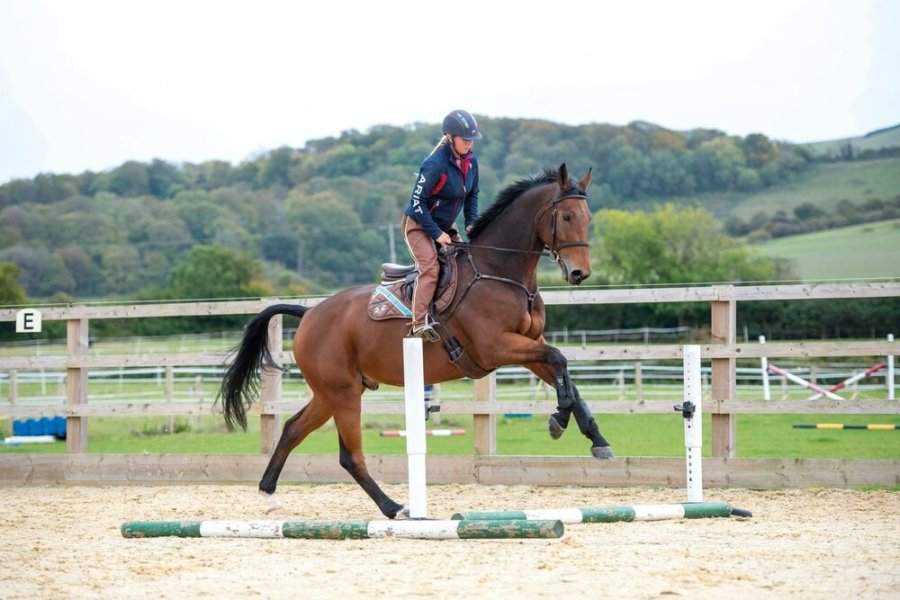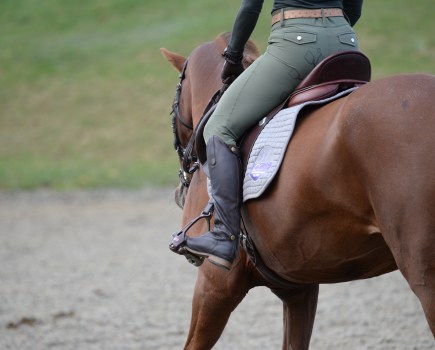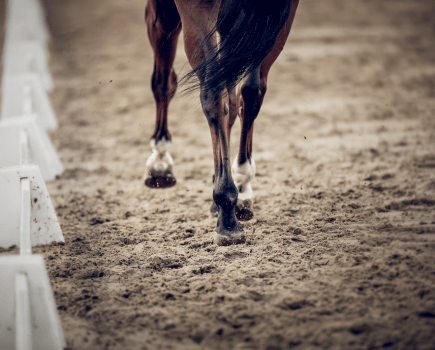Winter is a challenging time for horse owners, but it’s vital to keep your horse moving if they are going to stay fit, healthy and happy right through until spring. Regular exercise will help keep their brain happy, their limbs supple and their weight under control — whether that’s preventing too much creeping on, or top line falling off.
Easier said than done, I hear you say, but it doesn’t have to be. Your Horse asked event rider Sam Penn how to make the most of the few daylight hours you have available to ride and we’ve shared her five top tips below.
1. Spice it up with poles
Poles add a level of difficulty to a schooling session and a 20-minute burst of pole work is useful for developing your horse’s way of going and keeping them focused and fit.
“I place poles all around the arena, not really worrying too much about striding,” says Sam. “Make sure your horse walks out purposefully — really get them moving while also letting them stretch their neck.”
Poles placed randomly encourage your horse to think about what they’re doing with their feet, keeping their mind active too.
“If you find they’re getting too onwards, ask them to walk really slowly and then let them go forwards again — it’s a good exercise in you taking control,” adds Sam.
Now transition into trot and ride the poles again, this time taking some of them at an angle to keep your horse interested and up the concentration levels needed.
“Encourage your horse to stretch, then collect them for a number of shorter strides and you’ll be developing their balance, rhythm and cadence too,” explains Sam.
2. Bowl on in canter
Canter is a great tool to focus on for keeping up the fitness levels.
“During winter I use the school for this canter exercise unless the ground is holding up well,” says Sam. “I’m not talking about a schooling canter here, but a ‘get going’ canter where the aim is to raise your horse’s heart rate.”
Let your horse bowl on down the long sides, staying off their back, then sit down and rebalance for the short sides but without slowing too much.
You can even put in a 15m circle — if they break into trot, simply pick them up again.
“Try riding the ‘on and back’ exercise for a few circuits to develop your horse’s balance. For this, ask for a few strides of medium canter, then sit and collect for a working canter before coming back into medium.”
Ride this exercise on both reins, using trot across the centre line to change onto the correct lead. If your school is small, ride this exercise in a slower canter but for longer.
3. Time to lunge
If the weather really is too gross to ride or you have limited time, lunge instead with just a single lunge line and no tack or gadgets.
Let your horse have a buck and stretch if they want to as this will help them let off steam. Sometimes, free lungeing like this is just as useful as controlled work and definitely good for their state of mind.
A vigorous, rug-free roll in the school afterwards will add to the pleasure.
4. Use verges, logs and raised banks
You don’t have to hack for hours for it to be an effective workout.
“The key is to have a plan,” says Sam. “When time is short, don’t let your horse slop along on a long rein. Instead get them working to make it a really worthwhile and enjoyable session for both of you. Hacking puts miles and experience on your horse and will develop his confidence too.”
30 minutes is all you need for an effective hack.
“I walk for 10 minutes — five at the beginning and five at the end — and do 20 minutes of work in the middle,” explains Sam. “To make the hack interesting, and also help to develop my horse at the same time, I look out for anything I can safely walk over. This includes logs, piles of twigs and raised grass banks, and if it’s safe to do so, I’ll go up and down grass verges. I will school on a hack too, riding big circles and transitions, especially on the grass if it’s not too boggy.”
Trot work on hacks is great for raising the heart rate and burning calories.
“I like to trot for a few minutes before taking a walk break and then trotting again — even doing this on the roads if it’s quiet,” adds Sam.
Be sure to maintain a good rein connection throughout and focus on keeping your horse’s trot swinging along, using a few half-halts to stay balanced and rhythmical.
“The only time I wouldn’t hack is when it’s icy as it’s too dangerous.Of course, you need to work with your horse’s temperament too. Some, for instance, just hate the wind so on particularly windy days choose something else to do instead of hacking.”
5. Jump on a serpentine
Ramp up your schooling by adding in a jumping session.
“If you just concentrate on warming up, jumping, then cooling off, this can be a particularly short but energetic session,” explains Sam. “Work on what you feel you need to improve — turns, skinnies or verticals, for instance — and plan ahead so you can get going straight away, maybe building the jumps the night before.”
Jumping allows your horse to fully use their body, while engaging their brain at the same time. For Sam’s favourite combined jumping and fitness exercise, place three fences down the centre line (so that each jump is parallel to the long sides of the arena). Place one fence at each end (close to markers A and C — but leaving enough space to get around them) and the third fence in the middle of the arena over X.
“Make the fences as small as you need them to be and, if you’d rather jump across-pole than an upright, that’s fine,” says Sam. “Keeping the fences small is handy because it’s unlikely that you’ll need to keep getting off to rebuild them.”
Ride a three-loop serpentine in trot, going around the jumps first to check your horse is supple, balanced and listening. Now ride a serpentine again, but instead of going around the jumps, go over them — in trot is fine.
“The turns may seem tight at first, but by using your aids and bodyweight correctly your horse will soon get the message. If it proves too tricky for them, just use the first and last fence for the exercise initially, giving you and your horse more space and time,” says Sam. ”You can ride this exercise in canter if your horse is more established, using your bodyweight to change leg over the fence.”










